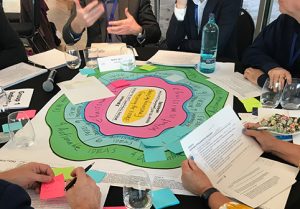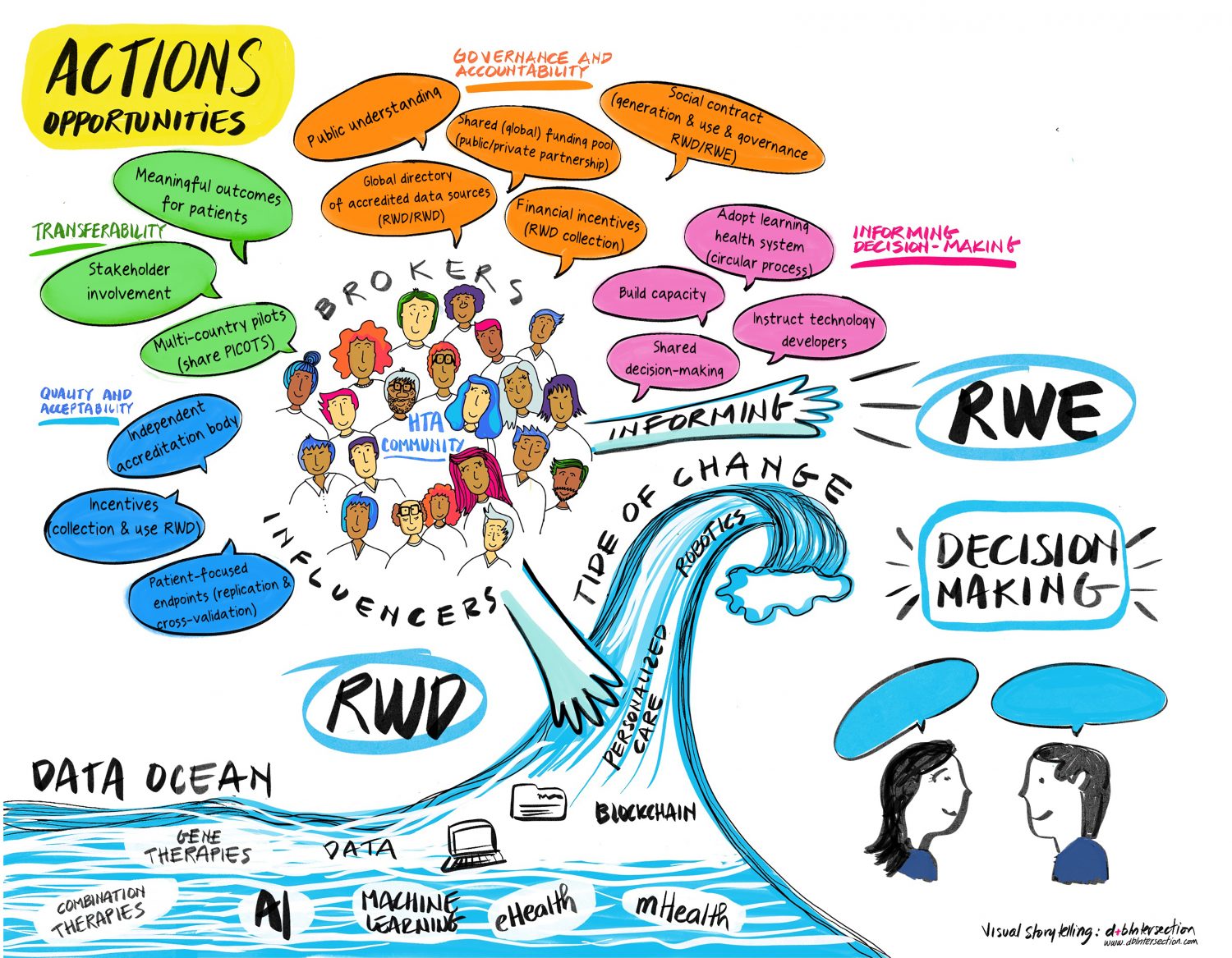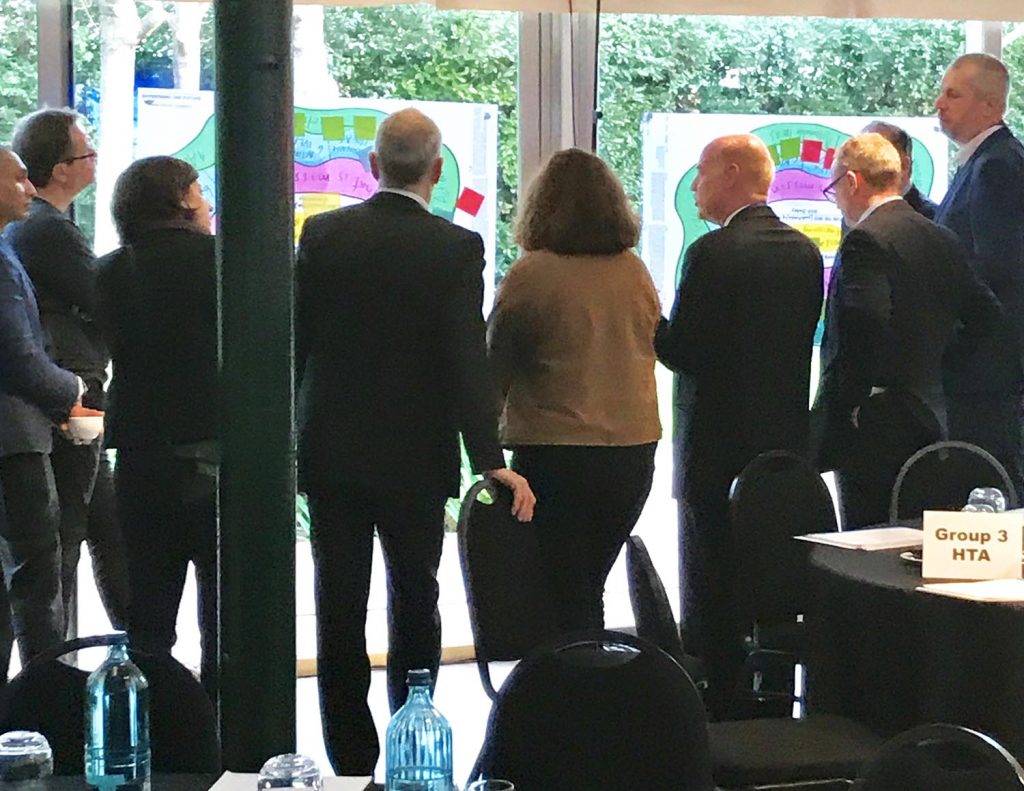Case Study: Design Thinking and Ad-hoc visual tools at Health Technology Assessment International (HTAi) Global Policy Forum Main Meeting
In January, we had the opportunity to organize a co-creation workshop with Health Technology Assessment International (HTAi) for their Global Policy Forum in Barcelona. HTAi is a renowned, international non-profit society comprised of professors, scientists, and stakeholders. These members assess health technologies and inform policy on the use of these technologies. The purpose of this workshop was to create a collaborative, inclusive, and participatory working environment to help HTAi achieve their main objective – to provide a common space for strategic discussions, to develop key messages and action items to take home for HTAi Agencies and industry, and to address key challenges and utilize the opportunities linked to the use of RWD and RWE to inform decision making.

What We Did
D+B worked with HTAi to facilitate a hands-on 3-day design thinking workshop. Together, we helped over 80 HTAi members to use a visionary perspective and work in a more collaborative and open-minded manner while they worked to address their current, medium, and long-term challenges. HTAi requested that D + B Intersection:
1. Facilitate dynamics and tools for group discussions in order to help participants to identify actions to help overcome the current challenges the organization faces.
2. Inspire creative thinking to envision actions opportunities for the short and long term future in which HTAi bodies and industry work collaboratively with other relevant stakeholders in adjusting the HTAi process to the new requirements demanded of them.

The workshop took place in a large, well-lit room equipped with eight round tables. Alexandra Etel (CEO and Innovation Architect) and the chair of HTAi trained eight HTAi members to be facilitators and provided them with clear, specific instructions to follow when leading the workshop. Once briefed on the instructions, a facilitator led the workshop at each respective table. The main goal of these facilitators was to promote an active group discussion and to ensure that all group members participated in the conversation.
How did we tailor the workshop to help HTAi promote balanced participation among group members, and what were the positive impacts?
We:
- Helped participants work and discuss together more collaboratively.
- Led activities that promoted open-mindedness among employees
Provided customized Design Thinking visual tools that allowed every participant to have his or her voice heard. - Created a stimulating environment in which employees could stand up, move around, and work in a more active, creative manner.
- Devised new ways for members to collaborate with each other.
- Constructed a compelling and unique visual storytelling that highlighted the main takeaways from the Global Policy Forum and future actions opportunities for action that HTAi could take advantage of.

Alexandra Etel specializes in utilizing design thinking for both visual business strategy design and corporate workshops. In the case of HTAi, design thinking helped the participants to:
- Understand the current situation of the organization.
- Identify the primary challenges and opportunities of using RWD/RWE in the context of HTAi.
- Propose actions through an idea generation session with tailored visual tools.
- Identify and select key, feasible actions to achieve those solutions in the short, medium, and long term.
- Create a common roadmap with actions opportunities.

Actions Opportunities Roadmap Visual Storytelling
What made D+B Intersection’s services unique and valuable to HTAi?
- The workshop and visual tools were created and tailored specifically to HTAi and their organization’s core values and needs.
- The visual storytelling with Actions Opportunities created by Alexandra, a former designer and architect, was visually dynamic, engaging, and professional.
- We truly listen to the organization’s needs, empathize with their objectives, and unite their team to deliver positive results with enthusiasm and professionalism.

The Main Outcome
Overall, we empowered HTAi members creatively engage with one another and be more collaborative, resulting in a positive impact on the company. After the workshop, HTAi reported an increase in creativity and productive collaboration among its members. As a matter of fact, HTAi recently mentioned to us that they would implement the dynamics and visual tools used in the workshop in future collaborative strategic design sessions. It was a great honor and opportunity to design a creative journey and a hands-on experience that opened participants’ minds to new ways of working together creatively!
